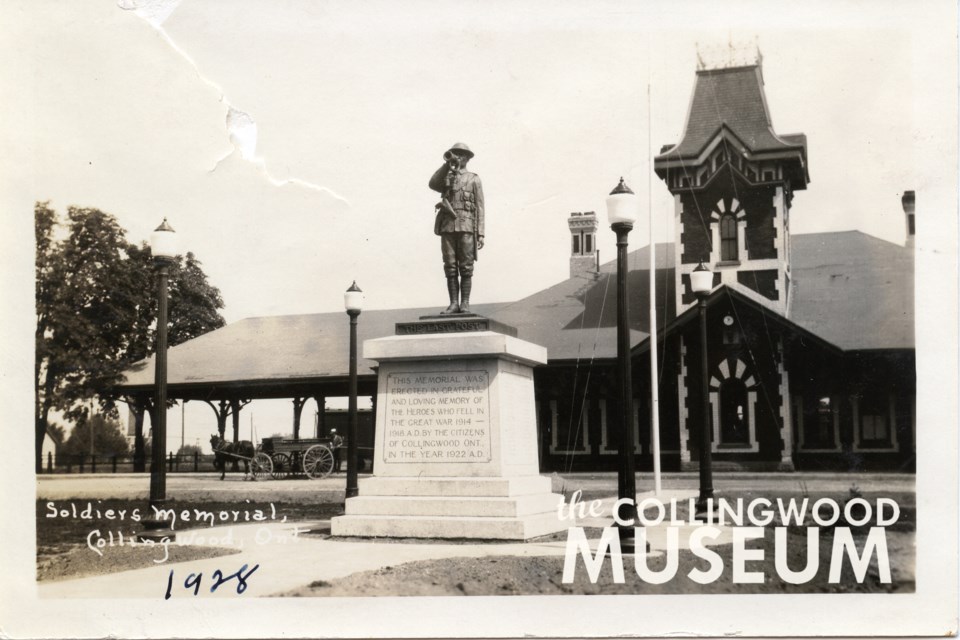Collingwood’s cenotaph – a bronze-cast statue of a bugler – has a heartwarming origin story about two brothers, both veterans of the First World War. One the artist and architect behind the statue, the other the inspiration.
But there’s another story behind the cenotaph – this one steeped in controversy and politics. A story about a town divided.
In 1985, Isabel Griffin wrote a three-part column for the Enterprise-Bulletin entitled “Our Controversial War Memorial, in it, she detailed a decades-long process to build a war memorial, the location of which proved quite controversial, and may have involved a bit of trickery.
As early as 1917, women in Collingwood proposed a plan for a memorial park at Hume and Hurontario Streets. The property was, at that time, owned by George Leach of Duntroon.
Today it is being developed into a condominium and commercial complex known as Monaco, for years it was the site of Admiral School.
The idea of a war memorial came up again in 1919, again the Leach property was suggested but there was also a campaign (including a petition) to have the memorial erected on the library grounds (which were located at Maple and Second Street).
In 1922, town council voted to appoint a special committee for the memorial and authorized them to put the memorial on the library property.
Records printed in the Enterprise-Bulletin in 1922 showed the results of a public vote on the matter. There were three sites considered in the vote, the library grounds received 285 votes, the station grounds received 222, and Leach’s park received 271.
However, on Feb. 16, 1922, council withdrew the motion and Mayor Holden was given power to appoint a committee to recommend the best site.
The committee proposed purchasing Leach’s park for “the sole use and benefit of the townspeople, and to designate it in loving memory of our fallen heroes.”
Through letters to the editor published by the Enterprise-Bulletin, Griffin’s column explored the controversy surrounding the location of the cenotaph.
The mayor’s wife wrote a letter to the editor of the Enterprise-Bulletin asking the public to consider the idea the memorial will need space and suggested if the cost of Leach’s Park was too high, it could fit on the station grounds, “which can be had for nothing.”
Another letter signed “Taxpayer” suggested the town “didn’t want a repetition of our hidden post office.”
In October, 1922, the base for the cenotaph arrived and someone, without proper authority, ordered the base unloaded and placed in Leach’s Park, which was not yet owned by the town.
The proverbial can of worms was opened.
At the next council meeting, accusations and questions flew.
Did the mayor have the base of the Soldiers’ Memorial placed at Leach’s Park to force the town to buy the property?
One paper, the Messenger, suggested it was an alderman who favoured the Leach site who had it placed there.
At one council meeting, there was an altercation reported in local papers during which the mayor “seized an ink-pot” and an alderman grabbed a water pitcher, “and threatened to exchange shots.”
In February, 1923, under a new mayor, J.R. Arthur, an agreement was reached with Canadian National Railway to put the memorial there. The base was moved from Leach’s Park to the station grounds for $90 by Ben Teskey, who used teams of horses and log skids to complete the task.
On August 5, 1923, the memorial was officially unveiled on the train station grounds, where it remains today, with a ceremony including returned soldiers and nursing sisters. There was a wreath-laying ceremony and Charles Brindley played the Last Post.
The memorial was created by Charles Macdonald, a Collingwood resident who joined the army in August 1914, and was overseas by September 18, 1914. He was wounded and captured in April 1915, and remained a prisoner of war for three years.
He used his brother Fred to model the bugler for the monument. Fred Macdonald joined the army at the same time as his brother and was also wounded at Langemark. He escaped and returned to battle later.
*Special thanks to the Collingwood Museum and its staff for providing photos and research materials for this story.



